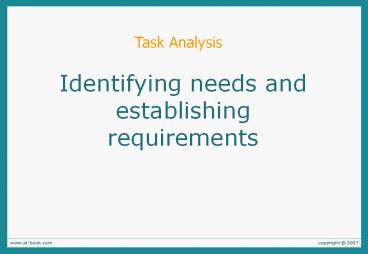Identifying needs and establishing requirements - PowerPoint PPT Presentation
Title: Identifying needs and establishing requirements
1
Identifying needs and establishing requirements
Task Analysis
2
Task analysis
- Task descriptions are often used to envision new
systems or devices - Task analysis is used mainly to investigate an
existing situation - It is important not to focus on superficial
activities What are people trying to achieve?
Why are they trying to achieve it? How are
they going about it? - Many techniques, the most popular is Hierarchical
Task Analysis (HTA)
3
Hierarchical Task Analysis
- Involves breaking a task down into subtasks, then
sub-sub-tasks and so on. These are grouped as
plans which specify how the tasks might be
performed in practice - HTA focuses on physical and observable actions,
and includes looking at actions not related to
software or an interaction device - Start with a user goal which is examined and the
main tasks for achieving it are identified - Tasks are sub-divided into sub-tasks
4
Hierarchical Task Analysis
example
0. In order to borrow a book from the library
1. go to the library 2. find the required
book 2.1 access library catalogue 2.2 access
the search screen 2.3 enter search
criteria 2.4 identify required book 2.5 note
location 3. go to correct shelf and retrieve
book 4. take book to checkout counter
5
Hierarchical Task Analysis (plans)
example
plan 0 do 1-3-4. If book isnt on the shelf
expected, do 2-3-4. plan 2 do 2.1-2.4-2.5. If
book not identified do 2.2-2.3-2.4.
6
Hierarchical Task Analysis (graphical)
example
Borrow a book from the library
0
plan 0 do 1-3-4. If book isnt on the shelf
expected, do 2-3-4.
go to the library
find required book
retrieve book from shelf
take book to counter
3
2
1
4
plan 2 do 2.1-2.4-2.5. If book not identified
from information available, do 2.2-2.3-2.4-2.5
access search screen
enter search criteria
identify required book
access catalog
note location
2.1
2.2
2.3
2.4
2.5
7
Predictive models
- Provide a way of evaluating products or designs
without directly involving users - Psychological models of users are used to test
designs - Less expensive than user testing
- Usefulness limited to systems with predictable
tasks - e.g., telephone answering systems,
mobiles, etc. - Based on expert behavior
8
GOMS (Card et al., 1983)
- Goals - the state the user wants to achieve e.g.,
find a website - Operators - the cognitive processes physical
actions performed to attain those goals, e.g.,
decide which search engine to use - Methods - the procedures for accomplishing the
goals, e.g., drag mouse over field, type in
keywords, press the go button - Selection rules - determine which method to
select when there is more than one available
9
Keystroke level model
- GOMS has also been developed further into a
quantitative model - the keystroke level model. - This model allows predictions to be made about
how long it takes an expert user to perform a
task.
10
Response times for keystroke level operators
(Card et al., 1983)
example
11
Summary
- Task analysis techniques such as HTA help to
investigate existing systems and practices - Predictive models are used to evaluate systems
with predictable tasks such as telephones. - GOMS, Keystroke Level Model, Fitts Law predict
expert, error-free performance.































